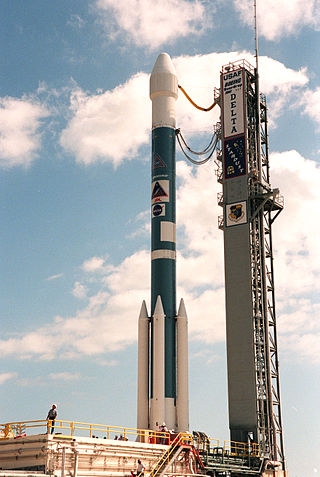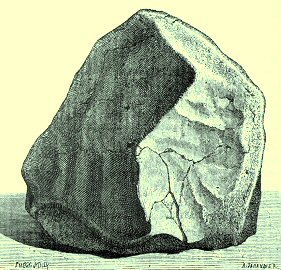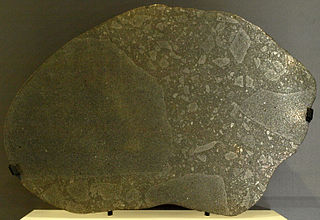Geochemistry is the science that uses the tools and principles of chemistry to explain the mechanisms behind major geological systems such as the Earth's crust and its oceans. The realm of geochemistry extends beyond the Earth, encompassing the entire Solar System, and has made important contributions to the understanding of a number of processes including mantle convection, the formation of planets and the origins of granite and basalt. It is an integrated field of chemistry and geology.

A chondrule is a round grain found in a chondrite. Chondrules form as molten or partially molten droplets in space before being accreted to their parent asteroids. Because chondrites represent one of the oldest solid materials within the Solar System and are believed to be the building blocks of the planetary system, it follows that an understanding of the formation of chondrules is important to understand the initial development of the planetary system.

Presolar grains are interstellar solid matter in the form of tiny solid grains that originated at a time before the Sun was formed. Presolar grains formed within outflowing and cooling gases from earlier presolar stars. The study of presolar grains is typically considered part of the field of cosmochemistry and meteoritics.

A chondrite is a stony (non-metallic) meteorite that has not been modified, by either melting or differentiation of the parent body. They are formed when various types of dust and small grains in the early Solar System accreted to form primitive asteroids. Some such bodies that are captured in the planet's gravity well become the most common type of meteorite by arriving on a trajectory toward the planet's surface. Estimates for their contribution to the total meteorite population vary between 85.7% and 86.2%.

Orgueil is a scientifically important carbonaceous chondrite meteorite that fell in southwestern France in 1864.

Carbonaceous chondrites or C chondrites are a class of chondritic meteorites comprising at least 8 known groups and many ungrouped meteorites. They include some of the most primitive known meteorites. The C chondrites represent only a small proportion (4.6%) of meteorite falls.

The Murchison meteorite is a meteorite that fell in Australia in 1969 near Murchison, Victoria. It belongs to the carbonaceous chondrite class, a group of meteorites rich in organic compounds. Due to its mass and the fact that it was an observed fall, the Murchison meteorite is one of the most studied of all meteorites.
Meteoritics is the science that deals with meteors, meteorites, and meteoroids. It is closely connected to cosmochemistry, mineralogy and geochemistry. A specialist who studies meteoritics is known as a meteoriticist.

The Tagish Lake meteorite fell at 16:43 UTC on 18 January 2000 in the Tagish Lake area in northwestern British Columbia, Canada.

The origin of water on Earth is the subject of a body of research in the fields of planetary science, astronomy, and astrobiology. Earth is unique among the rocky planets in the Solar System in having oceans of liquid water on its surface. Liquid water, which is necessary for all known forms of life, continues to exist on the surface of Earth because the planet is at a far enough distance from the Sun that it does not lose its water, but not so far that low temperatures cause all water on the planet to freeze.
The presence of water on the terrestrial planets of the Solar System varies with each planetary body, with the exact origins remaining unclear. Additionally, the terrestrial dwarf planet Ceres is known to have water ice on its surface.

The Allende meteorite is the largest carbonaceous chondrite ever found on Earth. The fireball was witnessed at 01:05 on February 8, 1969, falling over the Mexican state of Chihuahua. After it broke up in the atmosphere, an extensive search for pieces was conducted and over 2 tonnes were recovered. The availability of large quantities of samples of the scientifically important chondrite class has enabled numerous investigations by many scientists; it is often described as "the best-studied meteorite in history." The Allende meteorite has abundant, large calcium–aluminium-rich inclusions (CAI), which are among the oldest objects formed in the Solar System.

Enstatite chondrites are a rare form of meteorite, rich in the mineral enstatite. Only about 200 E-Type chondrites are currently known, comprising about 2% of the chondrites that fall on Earth. There are two main subtypes: EH and EL, classified based on their iron content.

101955 Bennu (provisional designation 1999 RQ36) is a carbonaceous asteroid in the Apollo group discovered by the LINEAR Project on 11 September 1999. It is a potentially hazardous object that is listed on the Sentry Risk Table and has the highest cumulative rating on the Palermo Technical Impact Hazard Scale. It has a cumulative 1-in-1,750 chance of impacting Earth between 2178 and 2290 with the greatest risk being on 24 September 2182. It is named after Bennu, the ancient Egyptian mythological bird associated with the Sun, creation, and rebirth.
CI chondrites, also called C1 chondrites or Ivuna-type carbonaceous chondrites, are a group of rare carbonaceous chondrite, a type of stony meteorite. They are named after the Ivuna meteorite, the type specimen. CI chondrites have been recovered in France, Canada, India, and Tanzania. Their overall chemical composition closely resembles the elemental composition of the Sun, more so than any other type of meteorite.
This is a glossary of terms used in meteoritics, the science of meteorites.
Asteroidal water is water or water precursor deposits such as hydroxide (OH−) that exist in asteroids. The "snow line" of the Solar System lies outside of the main asteroid belt, and the majority of water is expected in minor planets. Nevertheless, a significant amount of water is also found inside the snow line, including in near-earth objects (NEOs).
The K/U Ratio is the ratio of a slightly volatile element, potassium (K), to a highly refractory element, uranium (U). It is a useful way to measure the presence of volatile elements on planetary surfaces. The K/U ratio helps explain the evolution of the planetary system and the origin of Earth's moon.
CM chondrites are a group of chondritic meteorites which resemble their type specimen, the Mighei meteorite. The CM is the most commonly recovered group of the 'carbonaceous chondrite' class of meteorites, though all are rarer in collections than ordinary chondrites.

Alais or Allais is the first carbonaceous chondrite meteorite identified. It fell near Alès in 1806 in multiple fragments which together weighed 6 kg, although only 0.26 kg (9.2 oz) remains. The meteorite contains a number of elements in similar proportions to the Solar System in its primordial state. It also contains organic compounds and water. It has proved to be one of the most important meteorites discovered in France.












